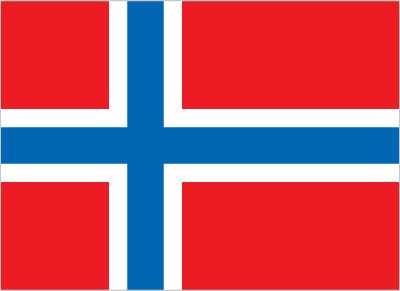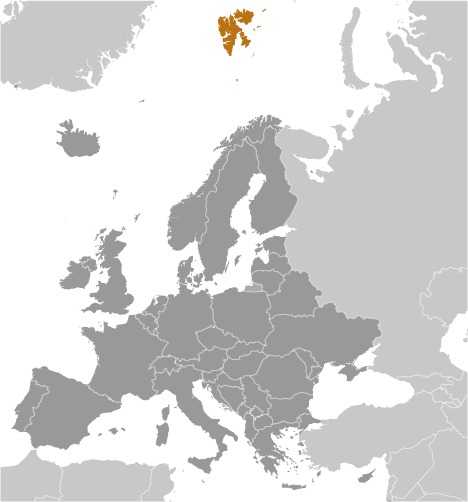Svalbard and Jan Mayen - SJ - SJM - Europe
Last updated: December 22, 2025



Svalbard Images
Svalbard Factbook Data
Dependency status
territory of Norway; administered by the Polar Department of the Ministry of Justice, through a governor (sysselmann) residing in Longyearbyen, Spitsbergen; by treaty (9 February 1920), sovereignty was awarded to Norway
Geographic coordinates
78 00 N, 20 00 E
Natural hazards
ice floes often block the entrance to Bellsund (a transit point for coal export) on the west coast and occasionally make parts of the northeastern coast inaccessible to maritime traffic
Area - comparative
slightly smaller than West Virginia
Background
Norse explorers may have first discovered the Svalbard archipelago in the 12th century. The islands served as an international whaling base during the 17th and 18th centuries. Norway's sovereignty was internationally recognized by treaty in 1920, and five years later Norway officially took over the territory. Coal mining started in the 20th century, and a Norwegian company and a Russian company are still in operation today. Travel between the settlements is accomplished with snowmobiles, aircraft, and boats.
Military and security forces
no regular military forces
Capital
name: Longyearbyen
geographic coordinates: 78 13 N, 15 38 E
time difference: UTC+1 (6 hours ahead of Washington, DC, during Standard Time)
daylight saving time: +1hr, begins last Sunday in March; ends last Sunday in October
etymology: the name in Norwegian means Longyear Town; the site was established by and named after John Munro LONGYEAR, whose Arctic Coal Company began mining operations there in 1906
geographic coordinates: 78 13 N, 15 38 E
time difference: UTC+1 (6 hours ahead of Washington, DC, during Standard Time)
daylight saving time: +1hr, begins last Sunday in March; ends last Sunday in October
etymology: the name in Norwegian means Longyear Town; the site was established by and named after John Munro LONGYEAR, whose Arctic Coal Company began mining operations there in 1906
Climate
arctic, tempered by warm North Atlantic Current; cool summers, cold winters; North Atlantic Current flows along west and north coasts of Spitsbergen, keeping water open and navigable most of the year
Coastline
3,587 km
Exchange rates
Norwegian kroner (NOK) per US dollar -
Exchange rates:
10.746 (2024 est.)
10.563 (2023 est.)
9.614 (2022 est.)
8.59 (2021 est.)
9.416 (2020 est.)
Exchange rates:
10.746 (2024 est.)
10.563 (2023 est.)
9.614 (2022 est.)
8.59 (2021 est.)
9.416 (2020 est.)
Executive branch
chief of state: King HARALD V of Norway (since 17 January 1991)
head of government: Governor Lars FAUSE (since 24 June 2021)
election/appointment process: none; the monarchy is hereditary; governor and assistant governor responsible to the Polar Department of the Ministry of Justice
head of government: Governor Lars FAUSE (since 24 June 2021)
election/appointment process: none; the monarchy is hereditary; governor and assistant governor responsible to the Polar Department of the Ministry of Justice
Flag
the flag of Norway is used
Independence
none (territory of Norway)
Judicial branch
highest court(s): Svalbard is subordinate to Norway's Nord-Troms District Court and Halogaland Court of Appeal, both located in Tromso
Land boundaries
total: 0 km
Land use
agricultural land: 0% (2018 est.)
other: 100% (2018 est.)
other: 100% (2018 est.)
Legal system
laws of Norway that explicitly apply to Svalbard, including the Svalbard Act, the Svalbard Environmental Protection Act, and certain regulations; the Spitsbergen Treaty and the Svalbard Treaty grant certain rights to citizens and corporations of signatory nations
Legislative branch
note: the Council acts much like a Norwegian municipality, with responsibility for infrastructure and utilities (including power, land-use and community planning, education, and child welfare); however, the state provides healthcare services
Maritime claims
territorial sea: 12 nm
contiguous zone: 24 nm
continental shelf: extends to depth of exploitation
exclusive fishing zone: 200 nm
contiguous zone: 24 nm
continental shelf: extends to depth of exploitation
exclusive fishing zone: 200 nm
International organization participation
none
Natural resources
coal, iron ore, copper, zinc, phosphate, wildlife, fish
Geography - note
northernmost part of the Kingdom of Norway; consists of nine main islands; glaciers and snowfields cover 60% of the total area
Economic overview
high-income Norwegian island economy; major coal mining, tourism, and research sectors; recently established northernmost brewery; key whaling and fishing base; home to the Global Seed Vault
Political parties
Conservative
Labor
Liberal
Progress
Socialist Left
Labor
Liberal
Progress
Socialist Left
Terrain
rugged mountains; much of the upland areas are ice covered; west coast clear of ice about half the year; fjords along west and north coasts
Government type
non-self-governing territory of Norway
Military - note
Svalbard is a territory of Norway, demilitarized by treaty on 9 February 1920; Norwegian military activity is limited to fisheries surveillance by the Norwegian Coast Guard (2025)
Country name
conventional long form: none
conventional short form: Svalbard (sometimes referred to as Spitsbergen, the largest island in the archipelago)
etymology: the archipelago was traditionally known as Spitsbergen, a Dutch name meaning "jagged peaks," but Norway renamed it Svalbard in the 1920s when it assumed sovereignty of the islands, from the Norwegian sval (cold) and bard (shore); the Norwegian name may have been used during the Norse era for other locations
conventional short form: Svalbard (sometimes referred to as Spitsbergen, the largest island in the archipelago)
etymology: the archipelago was traditionally known as Spitsbergen, a Dutch name meaning "jagged peaks," but Norway renamed it Svalbard in the 1920s when it assumed sovereignty of the islands, from the Norwegian sval (cold) and bard (shore); the Norwegian name may have been used during the Norse era for other locations
Location
Northern Europe, islands between the Arctic Ocean, Barents Sea, Greenland Sea, and Norwegian Sea, north of Norway
Map references
Arctic Region
Internet country code
.sj
Broadcast media
Norwegian Broadcasting Corporation (NRK) provides TV transmission to Svalbard via satellite; access to 3 NRK radio stations and 2 TV stations
National anthem(s)
title: "Ja, vi elsker dette landet" (Yes, We Love This Country)
lyrics/music: Bjornstjerne BJORNSON/Rikard NORDRAAK
history: official anthem, as a Norwegian territory
lyrics/music: Bjornstjerne BJORNSON/Rikard NORDRAAK
history: official anthem, as a Norwegian territory
This is an audio of the National Anthem for Svalbard. The national anthem is generally a patriotic musical composition - usually in the form of a song or hymn of praise - that evokes and eulogizes the history, traditions, or struggles of a nation or its people. National anthems can be officially recognized as a national song by a country's constitution or by an enacted law, or simply by tradition. Although most anthems contain lyrics, some do not.
Population distribution
the small population is primarily concentrated on the island of Spitsbergen in a handful of settlements on the south side of the Isfjorden, with Longyearbyen being the largest
Ethnic groups
Norwegian 61.1%, foreign population 38.9% (consists primarily of Russians, Thais, Swedes, Filipinos, and Ukrainians) (2021 est.)
note: foreigners account for almost one third of the population of the Norwegian settlements, Longyearbyen and Ny-Alesund (where the majority of Svalbard's resident population lives), as of mid-2021
note: foreigners account for almost one third of the population of the Norwegian settlements, Longyearbyen and Ny-Alesund (where the majority of Svalbard's resident population lives), as of mid-2021
Languages
Norwegian, Russian
major-language sample(s):
Verdens Faktabok, den essensielle kilden for grunnleggende informasjon. (Norwegian)
The World Factbook, the indispensable source for basic information.
major-language sample(s):
Verdens Faktabok, den essensielle kilden for grunnleggende informasjon. (Norwegian)
The World Factbook, the indispensable source for basic information.
Norwegian audio sample
Elevation
highest point: Newtontoppen 1,717 m
lowest point: Arctic Ocean 0 m
lowest point: Arctic Ocean 0 m
Ports
total ports: 3 (2024)
large: 0
medium: 0
small: 0
very small: 3
ports with oil terminals: 0
key ports: Barentsburg, Longyearbyen, Ny Alesund
large: 0
medium: 0
small: 0
very small: 3
ports with oil terminals: 0
key ports: Barentsburg, Longyearbyen, Ny Alesund
Population
total: 2,556 (2025 est.)
male: 1,353
female: 1,203
male: 1,353
female: 1,203
Area
total : 62,045 sq km
land: 62,045 sq km
water: 0 sq km
note: includes Spitsbergen and Bjornoya (Bear Island)
land: 62,045 sq km
water: 0 sq km
note: includes Spitsbergen and Bjornoya (Bear Island)
Net migration rate
-5.57 migrant(s)/1,000 population (2021 est.)
Population growth rate
-0.03% (2019 est.)
